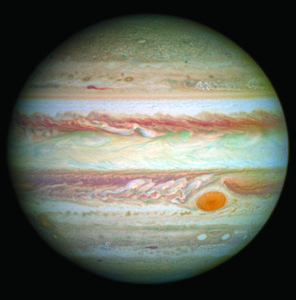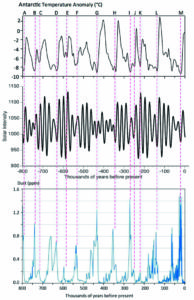
In a field so burdened with propaganda, corruption, and vast nonsense, it might seem very unlikely for any real scientific progress, despite the investment of hundreds of billions of dollars of American taxpayer money. And indeed the remarkable discovery reported here was accomplished far from taxpayer dollars and involves none of the luminaries associated with this field. Ralph Ellis of France and Michael Palmer of Canada published this pioneering paper in Geoscience Frontiers: “Modulation of ice ages via precession and dust-albedo feedbacks.”
“X- Factor”
This story begins with a search for the “X-Factor” that has long been suspected of causing the monumental shift of the Earth’s climate out of the 100,000 year ice ages into brief interglacials, such as the present Holocene Climate Optimum. Al Gore popularized the ice core temperature reconstructions that show the very periodic ice ages and the very close correlation of global temperatures with atmospheric carbon dioxide. (See Figure 1)

But Gore is the polar opposite of a scientist and wrongly assumed that carbon dioxide caused the global temperature variations. Had he possessed any scientific training, he would have at least acknowledged that the correlation could have indicated that CO2 caused temperature or that temperature caused CO2 or something else caused both. These are the logical possibilities. But having settled on CO2 as the cause in order to mesh with James Hansen’s Global Warming theory, he refused to back down. When a closer look at the ice core temperature reconstructions revealed that temperature typically precedes the rise in CO2 by centuries, Gore still kept touting CO2 as the cause. Politicians never let reality influence what they say, because it is just too inconvenient! ‘Hansen Warming’ had to be correct, even if it was not.
Jupiter as the cause of climate change

Had Gore been able to understand slightly complex arguments, he would have realized that the very periodic behavior of the Earth’s ice age cycles going back almost a million years, demands a very periodic explanation. That explanation was originally developed by the Serbian physicist Milutin Milankovitch, who demonstrated that changes in the Earth’s orbit caused largely by the giant planet Jupiter changed the amount of incoming solar radiation (‘insolation’) at the all important Arctic latitude of 65 degrees North, thereby causing massive continental glaciers to form or to melt. Because these glaciers were far whiter than the bare ground, they reflected much of the insolation back to space before it could warm the region, thereby ensuring that the snow did not melt and ice sheets thousands of feet thick eventually formed.
Milankovitch identified three elements of the Earth’s orbit that are altered by Jupiter (‘Precession’ of the Earth’s axis of rotation, much as a spinning top or gyroscope precesses, ‘Obliquity’ or tilt of the axis with respect to the Plane of the Ecliptic that produces our seasons, and the “Eccentricity’ of our slightly elliptical orbit about the Sun.) Of these, ‘Precession’ is the most dramatic, producing 5,000 year ‘Great Summers’ and 5,000 year ‘Great Winters.’ Obliquity and Eccentricity have much longer cycles, “somehow” combining with Precession to produce 100,000 year Ice Ages and 10,000 year Interglacials.
It is the “somehow” that has eluded us until now.
“Dust” is the X-Factor
In the ice core temperature reconstructions, it is easy to see the Earth’s temperature ratcheting down over the 23,000 year cycles of precession, unable to pull out during successive Great Summers. As snow and ice cover ever more of the Northern Hemisphere, the Earth’s deep freeze gets ever more intense.
Then suddenly one of the precessional Great Summers kicks us out of an ice age into a brief interglacial, until that Great Summer gives way to another Great Winter, and the Earth falls back into the next long ice age.

Why is one Great Summer so much more potent than others? The answer has been elusive, until now. Those who study the ice cores from Greenland and Antarctica noticed that dust is far more evident in the ice before the Great Summer that leads to so much warming that the Northern Hemisphere continental glaciers melt and the global temperature rises. (See Figure 3)
Where did the massive amounts of dust originate and why?
Researchers were able to trace the dust found in Antarctic ice cores to Patagonia in Argentina, using isotope techniques. Similarly, the dust found in Greenland ice cores could be traced to the Gobi and Taklamakan deserts in Mongolia and China.
Some of these regions are covered with grasses today. holding the soil together. Why were they barren wastelands feeding massive dust storms just 20,000 years ago? The answer comes from recent NASA satellite studies showing the greening of the Earth, as atmospheric carbon dioxide has risen. Dry areas have turned green, because plants become more drought tolerant from more carbon dioxide. And they certainly grow far better under all conditions with higher levels of CO2.
Reversing that logic says that plants have much more difficulty growing at all, let alone in harsh high desert conditions, if starved for CO2. In fact below about 200 ppmv, they hardly grow at all. That makes today’s 400 ppmv exceedingly beneficial to life on Earth.
Looking back at Al Gore’s favorite graph of global temperatures and atmospheric CO2 derived from ice cores, we see that carbon dioxide was below the threshold for plant life to easily survive. Those trying to grow in harsh conditions could no longer do so and perished. Life itself was dying, as our colder oceans absorbed ever more of the life-supporting CO2 in our atmosphere. Grasslands reverted to deserts, and started to blow away in what must have been a vast dust bowl, similar to the ‘Dust Bowl’ of 1930s America, although cold rather than hot and long rather than short.
Was this the end of life on Earth?
The vast dust storms were prevalent for fifteen thousand years and must have been horrific. But they served a useful purpose. They turned the vast continental glaciers in the Northern Hemisphere dirty, such that their ‘albedo’ (whiteness) decreased, and they started to melt. That broke the bitterly cold hold that the glaciers held over the Earth, and our climate warmed dramatically during the next Great Summer. This quickly liberated CO2 from the oceans, returning the level to where it would once again support the plant life we depend upon today.
Atmospheric carbon dioxide was surely important to the Earth’s many escapes from ice ages, but not at all in the fashion promoted by Al Gore. It was the lack of CO2 that led to warming, not the abundance of it. Each excursion of CO2 below the threshold for plants to grow resulted in a massive die off. That led to massive dust storms, melting of glaciers, and Milankovitch cycle warming when the next Great Summer reappeared.
Had this succession of events not occurred, the Earth would remain perpetually frozen in a never-ending ice age, with Milankovitch cycles unable to bring about interglacials such as the Holocene Climate Optimum we currently enjoy.
What does this say about the future?
Astute observers will point out that we are already in another Great Winter, according to the Milankovitch precessional cycles. The Earth’s closest approach to the Sun is now in January, and hence Northern Hemisphere summers are now receiving the lowest insolation they typically get. We can clearly see that the global temperature has, on average, gradually declined over the Holocene due to this effect. Does that mean that we are about to experience a steep drop into the next Ice Age? Probably not.
With the other two Milankovitch cycles (Obliquity and Eccentricity) acting to counteract the present precessional Great Winter, we are likely to see the Holocene remain in place for tens of thousands of years. That will make this warm interglacial extremely unusual compared with previous ones that have lasted 10,000 years. There will continue to be substantial climate variations such as the Minoan, Roman, Medieval, and Modern Warm Periods that have so benefited mankind and the periods between of modest cold that have often shredded the fabric of civilization. But the drastic disaster of another ice age is apparently far off, thank goodness.
One word of caution. Science is always a work in progress. Hence these latest developments may change in the future as we learn more. But they certainly say that real climate science has moved far beyond the primitive notions of Al Gore and James Hansen.
Gordon J. Fulks lives in Corbett and can be reached at gordonfulks@hotmail.com. He holds a doctorate in physics from the University of Chicago’s Laboratory for Astrophysics and Space Research and has no conflicts of interest on this subject.
No Comments
Leave a comment Cancel